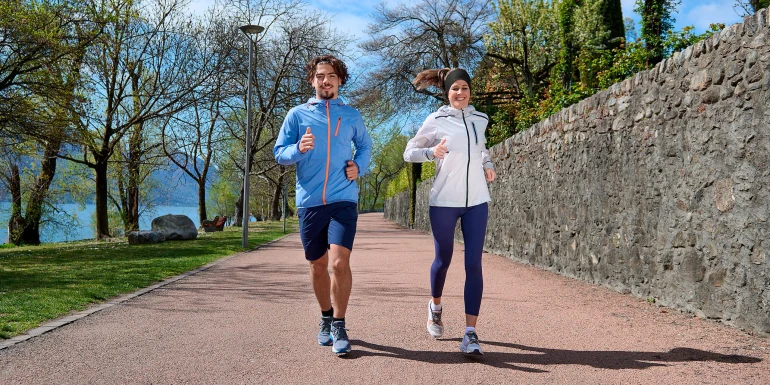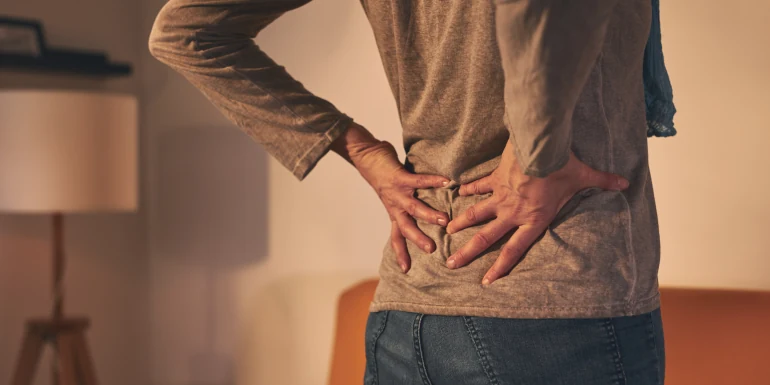
Fascia training – exercises for easing fascial tension
What exercises can you do to release fascial tension? How do you use a foam roller on your foot, and what can you do to ease tension in the fascia on your knee or chest? Find you what fascia training involves and what you need to look out for.
What is the fascia?
The fascia is a thin, web-like layer of tissue made of collagen fibres. It runs through every part of the body, forming a sheath around the muscles, bones, joints, organs, nerves and vessels. The individual fascial layers merge seamlessly with other types of tissue such as the meniscus and the intervertebral discs.
Researchers regard each of these layers as part of a single system, the fascia, which performs a variety of functions. It works in tandem with the muscles to transfer energy and movement. The fascia also plays a key role in the way we experience mobility, tension and pain, as it contains numerous movement receptors (proprioceptors) and pain receptors (nociceptors). Finally, the fascia also serves a protective function by encasing important parts of the body.
What is fascia training?
Fascia training encompasses a variety of exercises designed to support this network of connective tissue in our bodies. It uses specific techniques to relax the fascia by easing any tension or tightness in the affected area. The idea behind it is that tissue that is well supplied with blood will remain elastic, mobile and supple. But, when the fascia tightens up, our mobility is restricted, and we are more likely to experience tension and pain as a result.
In this situation, physiotherapists recommend fascia training. This is a therapy based on a series of manual techniques which uses aids such as foam rollers. Most practitioners will look at their patient’s body as a whole and attempt to address several complaints at once, and fascia training follows the same approach.
Another option is “functional fascia training”, which is often recommended by physiotherapists. This type of training is based on four elements:
- Bouncing movements such as jumping or rocking on your feet
- Stretching
- Using a foam roller
- Exercise to improve bodily awareness
And what exactly are the benefits of fascia training? Fascia training can help ease all the complaints mentioned above. It promotes the exchange of fluids in the tissue, which improves the supply of nutrients and in turn makes the fascial layers more supple.
Some studies have also shown that fascia training after sport can help ease aching muscles. However, there is little evidence to suggest that it does anything to improve mobility over the long term. There is also no clear definition of what constitutes a tight fascia. Despite this, many people talk about fascial tension, or fascial adhesion, usually in the context of porous, hardened, inflexible structures.
Training to release fascial tension: exercises
Fascia training is all about well-being, so you should always listen to your body and adjust the intensity of your training accordingly. Special aids like foam rollers are a great way to get started, and the exercises below can all help release fascial tension.
Foam rollers are usually made of rigid foam and are available in a variety of designs, from smooth models to textured options. They also come in varying degrees of firmness and a range of sizes. Beginners often find it easier to start with a softer foam roller, but you might want to try a few different types to see what works best for you. If in doubt, ask your physiotherapist for advice.
As well as the classic foam roller designs, there are also options with a built-in massage function. These are designed to release fascial tension with the help of vibration. Other aids include massage balls, which are also available in a wide variety of designs.
When should you avoid using foam rollers? You should not use a foam roller if you have any open wounds or swelling. If you suffer from cardiovascular disease, you should consult your doctor before commencing any form of fascia training.
Releasing fascial tension in the back
If you want to start fascia training for your back, you will need a massage ball and a foam roller. You can use the following exercises for your back:
- Fascia exercise 1: Lie on the floor on your right-hand side. Position the foam roller under the side of your lower back. Using your hand to support yourself, roll over the foam roller up to the middle of the side of your back. Repeat the exercise several times and then switch sides.
- Fascia exercise 2: This fascia training exercise is done standing against a wall. Start by pressing the foam roller against the wall with your buttocks, then slowly lower yourself down the wall into a partial squat, moving your lower back over the roller. Repeat the exercise several times.
- Fascia exercise 3: You will need a massage ball for this exercise. Sit on the floor with your knees bent, feet planted firmly on the floor, using your hands to support yourself. Position the massage ball under your right buttock, then slowly move back forth over the ball. If you notice any sensitive areas, massage them with the ball using a gentle circling motion. Repeat the exercise on your left-hand side.
Releasing fascial tension in the shoulder blades
There are also various massage ball and foam roller exercises you can do for your shoulders:
- Fascia exercise 1: Stand sideways against a wall. Position a massage ball between your upper arm and the wall. Pressing your upper arm against the ball, slowly bend your knees and then stand up again to massage the shoulder area. Do this exercise for about a minute on each side.
- Fascia exercise 2: For this fascia training exercise for the shoulder blades, start by leaning your back against a wall. Position a massage ball between your shoulder blades and the wall, then move the ball over the shoulder blades in a circular motion.
- Fascia exercise 3: You will need a foam roller for this shoulder exercise. Start by lying on the floor on your right-hand side. Position the foam roller under your right armpit. Using your left forearm to support yourself, hold your right arm out straight and slowly move the side of your back up and down the roller for one minute. Repeat this fascia training exercise on your other side.
Releasing fascial tension: exercises for the neck and throat
You can also use a foam roller on your throat and neck. Below are just two of the many fascia training exercises for these areas:
- Fascia exercise 1: Lie on your back, with a foam roller under your neck. Turn your head left and right for one minute.
- Fascia exercise 2: Position a mini foam roller or small massage ball behind your ear, then slowly roll it downwards along the neck muscles and collarbone, keeping the pressure constant. Repeat the process on the other side. This helps release fascial tension around the throat.
Tight fascia in the chest and abdomen
A full fascia training regime includes exercises for the abdomen:
- Fascia exercise 1: Position a mini foam roller on the upper middle part of your chest. Applying a small amount of pressure, move the roller down your body as far you feel comfortable.
- Fascia exercise 2: To release fascial tension in the abdomen, start by lying on your stomach. Position a massage ball on the area in the groin where you feel the most tension. Supporting your head on the backs of your hands, take a deep breath so your stomach gently presses on the ball, then exhale, relax and let your body melt onto the ball. Repeat the exercise. By the way, you can also use this type of fascia training to release fascial tension in the diaphragm. For this, simply position the ball under your ribs at the start of the exercise.
- Fascia exercise 3: This exercise can help release fascial tension without the need for a foam roller or a massage ball. It is based on yoga techniques. Stand up straight with your feet together. Take a deep breath, in and out. As you breathe out, bend down until your hands reach your ankles. Grasp your ankles and hold this position for a few breaths, then slowly return to your starting position, breathing in deeply. Remember to keep your back straight.
It’s worth noting that most standard foam rollers are actually not designed to be used on the abdomen. Massage balls, on the other hand, allow you to target specific areas during fascia training without putting too much pressure on the organs.
Releasing fascial tension in the legs
There are various methods of fascia training for targeting areas in the legs. Below are a few examples of leg exercises using a foam roller:
- Fascia exercise 1: Lie on the floor on your stomach. Get into a plank position, supporting yourself on your forearms and toes and keeping your body straight. Position the foam roller under your right thigh, just above the knee. Move the roller from your knee up to your hip, then switch to the other thigh.
- Fascia exercise 2: You can also use a foam roller to release fascial tension in your rear thighs. Start by sitting on the floor with your legs stretched out in front of you. Position the roller under your right knee. Support yourself by placing your hands on the floor behind you. Bend your left knee, planting your foot firmly on the floor. Applying as much pressure as possible, slide forwards so that the roller moves up towards your hips. Repeat the exercise on the left leg.
- Fascia exercise 3: Start on the floor with your legs stretched out in front of you. Position the foam roller under the centre of your right calf. Support yourself by placing your hands on the floor behind you. Bend your left knee, planting your foot firmly on the floor. Push your pelvis up and then slide your calf over the foam roller. Repeat the exercise for the left leg.
By the way, the thigh exercises described above using a foam roller can also help release fascial tension in the knees. This is because fascia training eases any tension in the thighs that may be putting strain on the knees.
Fascia training for the feet
There are also specific fascia training exercises you can do to focus on your feet. These include the following:
- Fascia exercise 1: Hold a small foam roller in place under your big toe. Support yourself on your other foot, holding on to a chair for balance if you need to. Slowly move your foot over the roller, using a series of short movements, from your toes to your heel. Slide your foot off the roller and repeat the exercise with the other foot.
- Fascia exercise 2: Start by standing up straight, with one foot on tiptoes. Push the heel of your other foot into the floor, while still keeping it flat. Hold this position for a few seconds and then switch feet.
- Fascia exercise 3: Sit on the floor and bend your knees, keeping your feet planted firmly on the floor. Run a foam roller or massage ball along the arch of one foot, from the tips of your toes to the start of your shin. You can continue moving the roller or ball up over your knee if it feels comfortable. Switch legs and repeat the exercise.
Releasing fascial tension in the arms
Try these exercises to relax the fascia in your arms:
- Fascia exercise 1: Start by lying on your back. Stretch out your right arm and position a foam roller under your upper arm. Supporting yourself with your other arm, move the roller back and forth between your shoulder and your elbow for a few minutes. Repeat the exercise on your left arm.
- Fascia exercise 2: Get down on all fours. Hold out your right arm with your palm facing inwards, then run your arm over a foam roller, back and forth, between your wrist and your elbow. Perform the exercise for a couple of minutes and then switch arms.
- Fascia exercise 3: Stand with your back to a wall. Hold your right arm out to the side with your palm facing the floor. Pin a foam roller against the wall with your upper arm, positioning the roller just above your elbow. Move along the wall, allowing the roller to glide along your arm, from your elbow to your shoulder. Repeat the exercise on your other arm.
Fascia training for the hands
Fascia training also includes a variety of hand exercises:
- Fascia exercise 1: Take a mini foam roller and place it upright on the floor. Applying a small amount of pressure, run the palms of your hands over the roller from left to right.
- Fascia exercise 2: Place your right hand on a table, palm facing downwards. Turn your palm to the right as far as possible. As you do so, move your arm backwards and feel the tension. Perform the same exercise on your left hand, turning your palm to the left this time.
- Fascia exercise 3: Place one finger flat on a mini foam roller, applying a small amount of pressure. Move your finger over the roller, repeating the exercise on each finger in turn.
As we age, our risk of osteoporosis (bone loss) increases. Therefore, experts recommend that elderly people get regular exercise. Balance and strength training are especially important, since both reduce the risk of falls in old age associated with bone loss. Gentle fascia training can be a useful addition here.
However, you should always talk to a doctor before you start your own fascia training programme. They will let you know which exercises are suitable for you. You might also consider fascia training under the supervision of a physiotherapist as an alternative.
Fascia training offers a number of potential benefits. The right combination of exercises can help promote mobility, ease tension and improve bodily awareness. Set aside a few minutes for yourself each day and making fascia training part of your routine.

The specialist provided the editorial team with advice and input for this article. Anja Roth (Master of Science in Musculoskeletal Physiotherapy) works for Helsana’s health consultation team. She helps customers with issues to do with prevention and health promotion.


Newsletter
Find out more about current health issues every month and get all the information you need about our attractive offers from all Helsana Group companies * delivered by e-mail to read whenever it suits you. Our newsletter is free of charge and you can sign up here:
We did not receive your information. Please try again later.
* The Helsana Group comprises Helsana Insurance Company Ltd, Helsana Supplementary Insurances Ltd and Helsana Accidents Ltd.